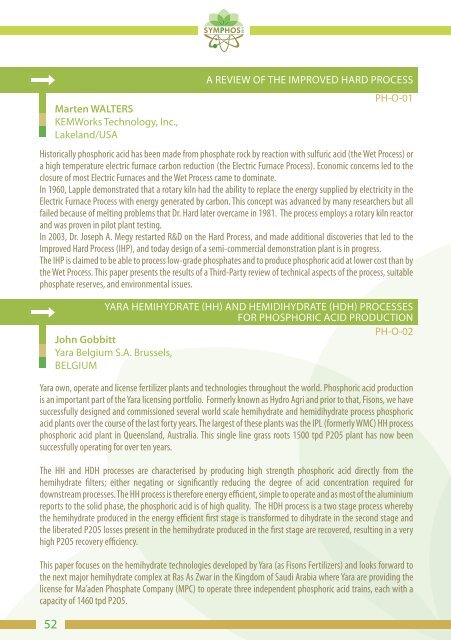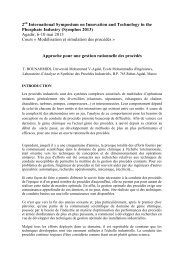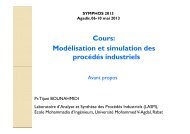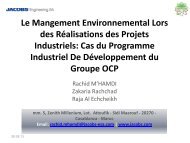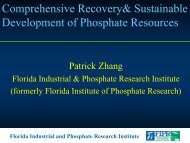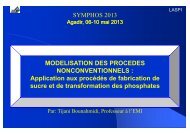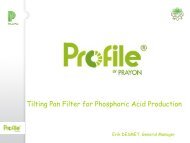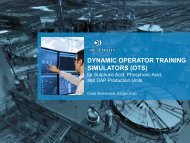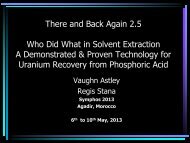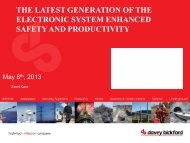Abstract SYMPHOS 2011
Abstract SYMPHOS 2011
Abstract SYMPHOS 2011
Create successful ePaper yourself
Turn your PDF publications into a flip-book with our unique Google optimized e-Paper software.
52<br />
Marten WALTERS<br />
KEMWorks Technology, Inc.,<br />
Lakeland/USA<br />
Historically phosphoric acid has been made from phosphate rock by reaction with sulfuric acid (the Wet Process) or<br />
a high temperature electric furnace carbon reduction (the Electric Furnace Process). Economic concerns led to the<br />
closure of most Electric Furnaces and the Wet Process came to dominate.<br />
In 1960, Lapple demonstrated that a rotary kiln had the ability to replace the energy supplied by electricity in the<br />
Electric Furnace Process with energy generated by carbon. This concept was advanced by many researchers but all<br />
failed because of melting problems that Dr. Hard later overcame in 1981. The process employs a rotary kiln reactor<br />
and was proven in pilot plant testing.<br />
In 2003, Dr. Joseph A. Megy restarted R&D on the Hard Process, and made additional discoveries that led to the<br />
Improved Hard Process (IHP), and today design of a semi-commercial demonstration plant is in progress.<br />
The IHP is claimed to be able to process low-grade phosphates and to produce phosphoric acid at lower cost than by<br />
the Wet Process. This paper presents the results of a Third-Party review of technical aspects of the process, suitable<br />
phosphate reserves, and environmental issues.<br />
John Gobbitt<br />
Yara Belgium S.A. Brussels,<br />
BELGIUM<br />
A REVIEW OF THE IMPROVED HARD PROCESS<br />
PH-O-01<br />
YARA HEMIHYDRATE (HH) AND HEMIDIHYDRATE (HDH) PROCESSES<br />
FOR PHOSPHORIC ACID PRODUCTION<br />
PH-O-02<br />
Yara own, operate and license fertilizer plants and technologies throughout the world. Phosphoric acid production<br />
is an important part of the Yara licensing portfolio. Formerly known as Hydro Agri and prior to that, Fisons, we have<br />
successfully designed and commissioned several world scale hemihydrate and hemidihydrate process phosphoric<br />
acid plants over the course of the last forty years. The largest of these plants was the IPL (formerly WMC) HH process<br />
phosphoric acid plant in Queensland, Australia. This single line grass roots 1500 tpd P2O5 plant has now been<br />
successfully operating for over ten years.<br />
The HH and HDH processes are characterised by producing high strength phosphoric acid directly from the<br />
hemihydrate filters; either negating or significantly reducing the degree of acid concentration required for<br />
downstream processes. The HH process is therefore energy efficient, simple to operate and as most of the aluminium<br />
reports to the solid phase, the phosphoric acid is of high quality. The HDH process is a two stage process whereby<br />
the hemihydrate produced in the energy efficient first stage is transformed to dihydrate in the second stage and<br />
the liberated P2O5 losses present in the hemihydrate produced in the first stage are recovered, resulting in a very<br />
high P2O5 recovery efficiency.<br />
This paper focuses on the hemihydrate technologies developed by Yara (as Fisons Fertilizers) and looks forward to<br />
the next major hemihydrate complex at Ras As Zwar in the Kingdom of Saudi Arabia where Yara are providing the<br />
license for Ma’aden Phosphate Company (MPC) to operate three independent phosphoric acid trains, each with a<br />
capacity of 1460 tpd P2O5.


